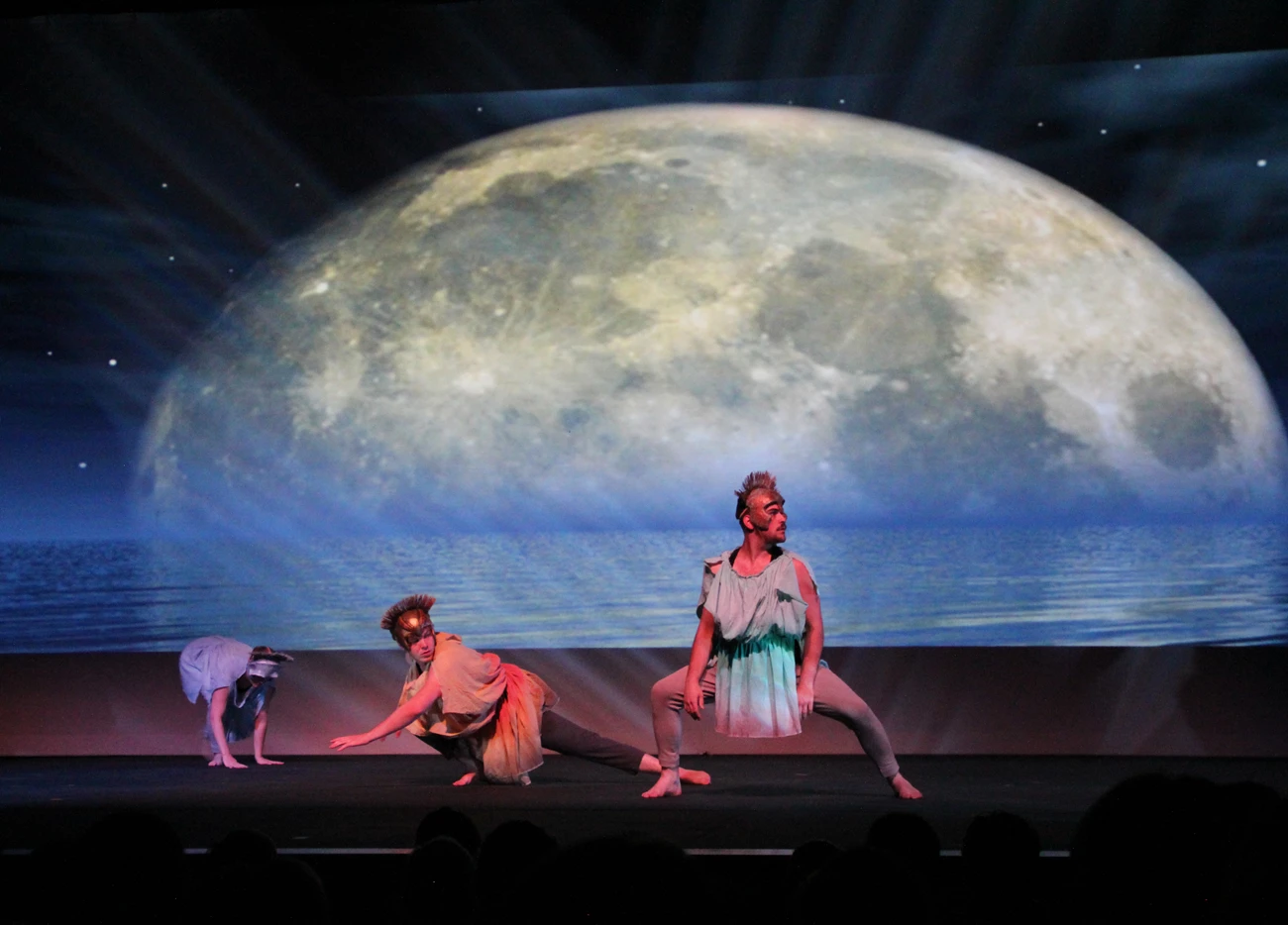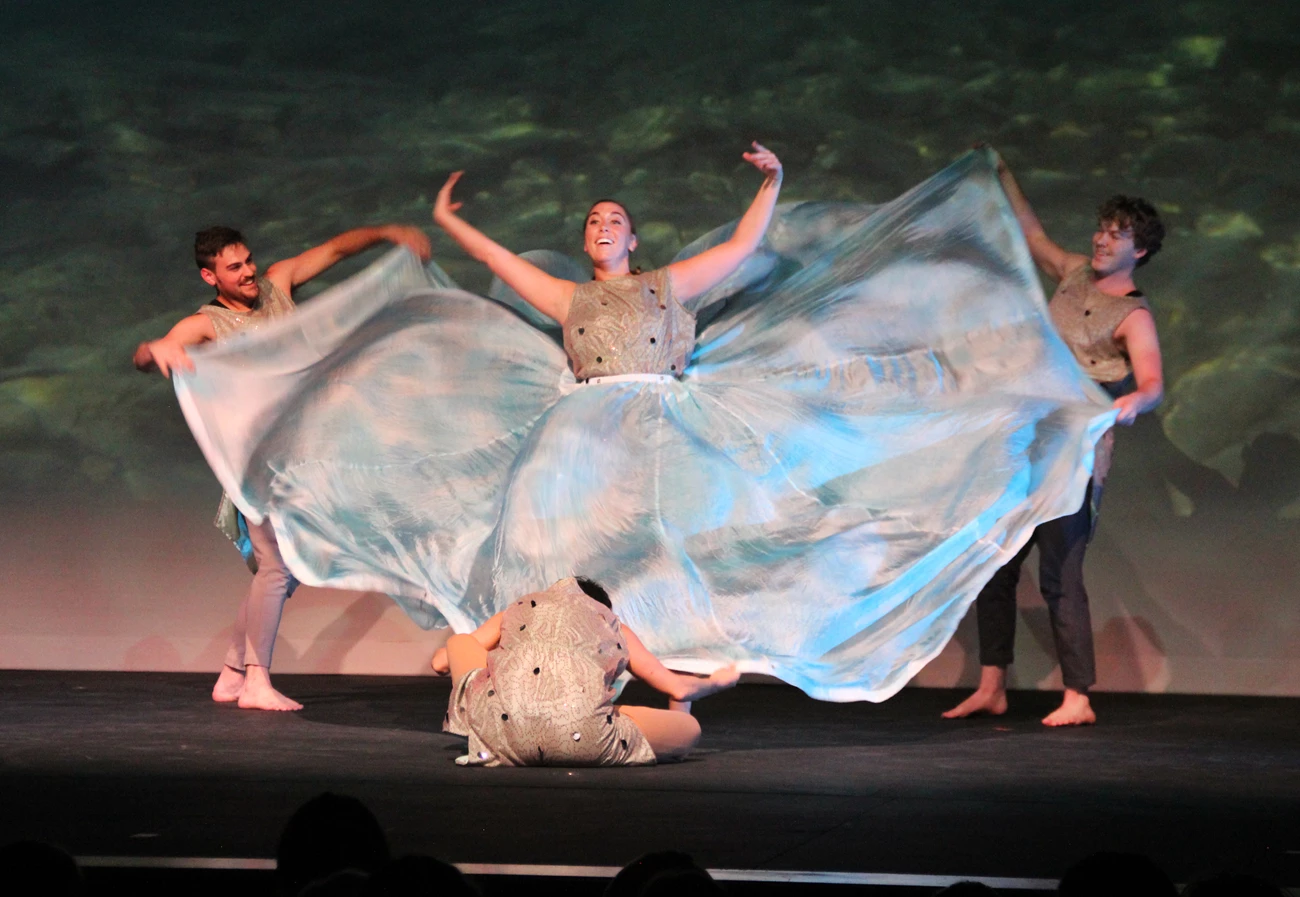By Melissa Sladek
Article
"Changing Balance/Balancing Change" Dance Performance

NPS/Melissa Sladek
The theater is dark. Bodies shift, seats creak, and voices whisper. An element of anticipation fills the air. But then, as if on cue, a hush permeates the darkened space. Lights illuminate a costumed dancer on stage, posed in a dramatic stance. Suddenly, the loud boom of a drum shakes the theater, a deep voice begins to speak, and the dancer comes to life.
No, I am not sitting in Carnegie Hall or the Lincoln Theater. I am in Whitefish, Montana, surrounded by 450 middle school students from schools around the Flathead Valley. And, believe it or not, we are all learning. Not about dance or music (although that too is a part of the hour-long performance we are here to see), but about science—climate change science to be exact.
The performance, Changing Balance/Balancing Change, is an immersive arts experience that weaves dance, music, narration, and movement to teach climate change science concepts and impacts occurring in northwest Montana. It is a performance that serves not only to teach about climate change, but about using movement to understand science concepts, and how the combination of science and art can create a better understanding of complex topics.
Creating such a piece is no easy task, however. It takes time, creativity, perseverance, funding, and most importantly, partnerships. Luckily, all of those factors came together for Karen Kaufmann, a University of Montana dance professor and the director of the CoMotion Dance Project, and for the Crown of the Continent Research Learning Center (CCRLC), one of Kaufmann’s partners.
The CoMotion Dance Project, based at the University of Montana, performs professional, educational performances and teaches dance integration within Missoula, Montana. Previous to Changing Balance/Balancing Change, Kaufmann and company created a similarly structured science education piece on fire ecology called Fire Speaks the Land, which they performed in northwest Montana in 2014 and 2015. The word spread amongst teachers and resource educators about this unique and successful way to teach science and eventually fell on the ears of staff at the CCRLC in Glacier National Park.
Immediately, we saw the value in combining art with science and thought that this innovative method of teaching complex science topics might be the perfect fit for learning about climate change impacts affecting Glacier National Park. Magically, Kaufmann agreed. A new partnership was then formed between the CoMotion Dance Project and the CCRLC and we began to work on obtaining funding for a new, interactive, educational dance performance on climate change.
We found support in Glacier’s partner, the Glacier National Park Conservancy, who also believed such a performance could be a great tool to teach climate change and subsequently funded the creation of Changing Balance/Balancing Change. In addition, many other partners contributed funds to make this performance a reality, including Glacier National Park, U.S. Forest Service Rocky Mountain Research Station, Montana Cultural Trust, University of Montana, and the Cadeau Foundation.
No, I am not sitting in Carnegie Hall or the Lincoln Theater. I am in Whitefish, Montana, surrounded by 450 middle school students from schools around the Flathead Valley. And, believe it or not, we are all learning. Not about dance or music (although that too is a part of the hour-long performance we are here to see), but about science—climate change science to be exact.
The performance, Changing Balance/Balancing Change, is an immersive arts experience that weaves dance, music, narration, and movement to teach climate change science concepts and impacts occurring in northwest Montana. It is a performance that serves not only to teach about climate change, but about using movement to understand science concepts, and how the combination of science and art can create a better understanding of complex topics.
Creating such a piece is no easy task, however. It takes time, creativity, perseverance, funding, and most importantly, partnerships. Luckily, all of those factors came together for Karen Kaufmann, a University of Montana dance professor and the director of the CoMotion Dance Project, and for the Crown of the Continent Research Learning Center (CCRLC), one of Kaufmann’s partners.
The CoMotion Dance Project, based at the University of Montana, performs professional, educational performances and teaches dance integration within Missoula, Montana. Previous to Changing Balance/Balancing Change, Kaufmann and company created a similarly structured science education piece on fire ecology called Fire Speaks the Land, which they performed in northwest Montana in 2014 and 2015. The word spread amongst teachers and resource educators about this unique and successful way to teach science and eventually fell on the ears of staff at the CCRLC in Glacier National Park.
Immediately, we saw the value in combining art with science and thought that this innovative method of teaching complex science topics might be the perfect fit for learning about climate change impacts affecting Glacier National Park. Magically, Kaufmann agreed. A new partnership was then formed between the CoMotion Dance Project and the CCRLC and we began to work on obtaining funding for a new, interactive, educational dance performance on climate change.
We found support in Glacier’s partner, the Glacier National Park Conservancy, who also believed such a performance could be a great tool to teach climate change and subsequently funded the creation of Changing Balance/Balancing Change. In addition, many other partners contributed funds to make this performance a reality, including Glacier National Park, U.S. Forest Service Rocky Mountain Research Station, Montana Cultural Trust, University of Montana, and the Cadeau Foundation.

NPS/Melissa Sladek
The performance was created and rehearsed throughout 2015-2016 and debuted in Glacier National Park during the National Park Service’s 2016 summer centennial celebrations. From our original vision discussed in the spring of 2015, the production blossomed into an educational and creative masterpiece involving a host of artists and collaborators. From Blackfeet singer/songwriter Jack Gladstone to the musical group the Whizpops, artists came together to share their talents and help create this dynamic, educational experience. Researchers from the US Geological Survey’s Climate Change in Mountain Ecosystems Program, climate educators from the CCRLC, and other climate change experts partnered with the CoMotion Dance Project on the piece’s science content.
A total of three performances were given in the park during the summer and two performances were given at the Whitefish Performing Arts Center to local middle school students in the fall. All total, 1,100 people attended the performances in northwest Montana! Additionally, the CoMotion Dance Project performed the dance at the University of Montana to over 800 Missoula students.
What’s next? Kaufmann is working with Montana PBS to create a televised version of Changing Balance/Balancing Change. Her goal is to share how climate change impacts are affecting our world using visible changes in Glacier National Park as a fulcrum. Kaufmann also hopes that this piece will open dialogue about what each of us can do to start making a change.
Back in the theater, I take a moment to survey the crowd. All around me, I see kids standing up, smiling and laughing while moving their bodies. They are following the instructions of the dancer on stage in order to show how glaciers form.
They are learning. They are having fun. I am learning. I am having fun. And I have a feeling that in the end, we will all leave knowing a little bit more about the world around us and our role within it.
A total of three performances were given in the park during the summer and two performances were given at the Whitefish Performing Arts Center to local middle school students in the fall. All total, 1,100 people attended the performances in northwest Montana! Additionally, the CoMotion Dance Project performed the dance at the University of Montana to over 800 Missoula students.
What’s next? Kaufmann is working with Montana PBS to create a televised version of Changing Balance/Balancing Change. Her goal is to share how climate change impacts are affecting our world using visible changes in Glacier National Park as a fulcrum. Kaufmann also hopes that this piece will open dialogue about what each of us can do to start making a change.
Back in the theater, I take a moment to survey the crowd. All around me, I see kids standing up, smiling and laughing while moving their bodies. They are following the instructions of the dancer on stage in order to show how glaciers form.
They are learning. They are having fun. I am learning. I am having fun. And I have a feeling that in the end, we will all leave knowing a little bit more about the world around us and our role within it.
Last updated: February 9, 2017
